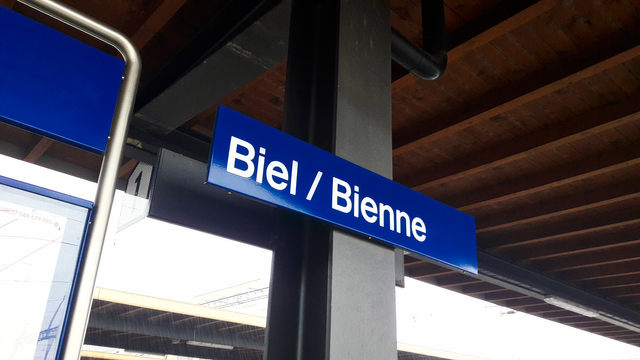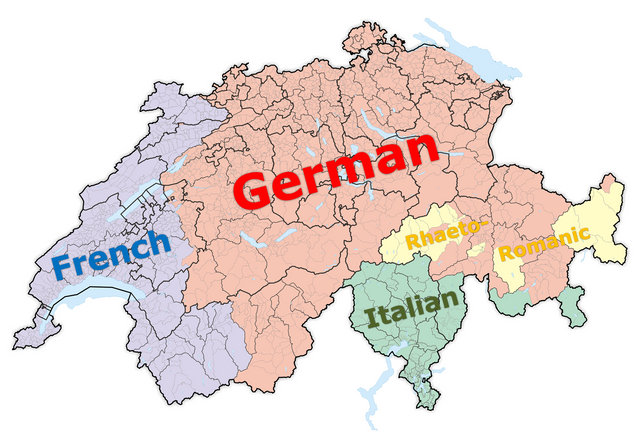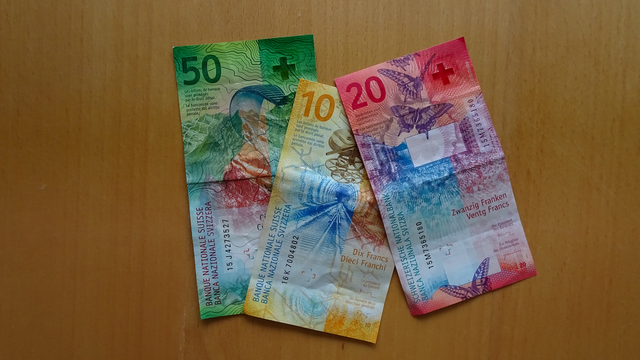Switzerland: One country, four languages, many dialects (5+ minutes read)
Switzerland has four official languages, but one of them is not actually spoken, one is not actually written, and two of the four are split into dozens of dialects so diverse that there is a considerable language barrier between some of them.
Die Schweiz: Ein Land, vier Sprachen, viele Dialekte (German)
D’Schwiiz: Eis Land, vier Sprache, vieli Dialäkt (Swiss German)
La Suisse : Un pays, quatre langues, beaucoup de dialects (French)
La Svizzera: Un paese, quattro lenguas, molti dialecti (Italian)
La Svizra: In staid, quarter linguas, blers dialects (Rhaeto-Romanic)
(Switzerland: One country, four languages, many dialects)

In Biel / Bienne, Switzerland’s biggest bilingual city, all street sign and public buildings (like the railway station) are labeled in both German and French.
If you’ve come to this blog to see picture of the beautiful Swiss landscapes, maybe you’re also interested in learning something about Swiss culture. I’ll start this mini-series with what naturally is the pinnacle of any country’s cultural character: its languages.
Switzerland’s language mosaic is particularly interesting and part of what makes this country’s culture unique. And it’s quite a complex matter as well.
Although different sub-cultures are associated with each language community, stemming naturally e.g. from consuming different medias, there is hardly any political friction, and the Swiss federation makes sure that each language region is equally represented and integrated on a national level. Most Swiss citizens are proud to be part of a nation which allows for the co-existence of many language communities.
Languages and geography
The four official languages of Switzerland are German, French, Italian, and Rhaeto-Romanic. As you can see on this map, the different languages are concentrated in different regions:

based on the image “Karte Schweizer Sprachgebiete 2018” on Wikimedia commons, originally licensed under the terms of the Creative Commons Attribution-ShareAlike 3.0 Unported license. Original author: Tschubby
German and French are, for the most part, spoken on the northern side of the Alps and in the Alpine valleys. There is a quite distinct line between the German-speaking and the French-speaking part, called the “Rösti-Graben” (Rösti ditch) by the German-speaking Swiss. There is, of course, no literal ditch, and it also has nothing to do with the Swiss national dish of the “Rösti”. Three of the 26 cantons (the top-level political subdivisions) of Switzerland are actually German / French bilingual (billingue [French]), where different regions of the Canton are either German-speaking or French-speaking: Bern / Berne, Freiburg / Fribourg, Wallis / Valais. The largest bilingual city in Switzerland is Biel / Bienne in the Canton of Bern.
The Italian-speaking community is confined to the Canton of Ticino at the southern end of the Swiss Alps, and to some valleys of the Canton of Graubünden.
Rhaeto-Romanic is spoken only in some valleys of the Canton of Graubünden. You may not have ever heard of this language before because it is not spoken elsewhere in the world.
Languages and dialects
Both German and Rhaeto-Romanic are split into a multitude of dialects.
Swiss German
While German is an official language of Switzerland and in its written form used by all German speakers as well as the government, it is not actually spoken by the native population, except at school or if addressing non-Swiss German speakers. However, all Swiss German speakers are fluent in German since it’s taught at school.
Local Swiss German dialects, sister languages of other German Dialects as they exist in Germany, Austria and Liechtenstein, are the spoken form of this language. Many of the 26 cantons have at least one regional dialect. These dialects have over centuries diverged so much that native speakers of one of them may not without major difficulties understand native speakers of others. For instance, the dialect spoken in the Canton of Wallis is considered to be especially difficult if not impossible to understand by outsiders. One thing all these dialects have in common is that they are very different from original German, and without training, a German speaker may not understand a Swiss German conversation. It is therefore a veritable “national secret language”.
On the other hand, the Swiss German dialects have neither an official written form nor an official grammar, also due to the fact that there are so many regional varieties. However, especially with the rise of mobile communications, many Swiss German speakers nowadays use their dialect to communicate with each other through text messages in an informal context rather than resorting to German; also because oftentimes, the Swiss German dialect is slightly less bulky:
Ig chum hüt später hei
Ich komm’ heute später heim.
(I’ll come home late today)
This “duolinguism” introduces a challenging language hurdle for the non-German speaking Swiss. The French and Italian speaking learn written German in school, but since there is no official Swiss German grammar, there are no Swiss German classes either. Thus, the non-bilingual French or Italian speaking Swiss will only speak “written” German. Either that, or both parties agree on one of the other official languages, or even English. The latter is, for instance, typically the case in purposefully mixed-language military service. To outsiders, when asking about how to learn Swiss German (especially by immigrated Germans), the typical answer is “Don’t”. Thus, many German speakers will eventually be able to understand Swiss German, but will not try to speak it themselves.
There is yet a third interesting component to the situation of the German language in Switzerland. Even if Swiss Germans speak the “official” version of German, they do so using a particular accent which to German ears may sound archaic. Germans who have never heard the actual Swiss German dialect sometimes think that this particular accent is what is called the Swiss German dialect which of course it isn’t. The funny thing is that most Swiss probably can speak accent-free German by imitating the “proper” German pronunciation, but (out of pride?) they simply choose not to.
French and Italian
The French and Italian languages, on the other hand, hardly divert from the official standards in France and Italy, respectively, whether written nor spoken. There are also hardly any regional differences.
The French-speaking are (sometimes condescendingly) referred to by the Swiss Germans as “Welsche”, meaning the Welsh. It is the equivalent to how the British Anglo-Saxons called their Roman-Celtic neighbors.
Rhaeto-Romanic
Rhaeto-Romanic is a very special case of its own. This language actually exists only as five greater and several minor dialects, all being spoken in a very compact geographical region in some valleys of the Canton of Graubünden. Some of these dialects exist in a written form as well.
Today, all Rhaeto-Romanic speakers also speak Swiss German and German fluently.
Because of its diversification, its close geographical confines and the low number of speakers, many of the Rhaeto-Romanic dialects are in immediate danger of extinction. Therefore, regional support of the local dialects is funded by the canton and the Swiss federation. Still, Rhaeto-Romanic is often dropped outside the Canton auf Graubünden in favor of English, and only very few living in the rest of Switzerland are able to understand it, let alone speak it.
One means to preserve the Rhaeto-Romanic language as such was the invention of an official unified written dialect (called Rumantsch Grischun) which today is used in official documents and national media. However, some fear that the newly-created dialect would actually compete with the existing “natural” dialects and accelerate their extinction, especially in their written form where Rumantsch Grischun is used almost exclusively on a federal level.
English
English is not an official language, but it is taught in school in all of Switzerland’s language regions. Original English cultural works such as books and films are by the majority of the population consumed in the translated / dubbed form, as is typically the case in Germany, France and Italy as well. In the last few decades, acceptance, spread and consumption of English has increased.
Languages and culture

Swiss banknotes. At the time of writing, these are worth about 35 STEEM
You can hardly look anywhere in Switzerland without being reminded of the multi-lingual nature of the nation. All national official institutions hold their names, abbreviations and logos in at least the three main national languages. Consumer product information is usually printed in these three languages. Official national IDs and banknotes are labeled in all four languages. Information issued to the general public, including communications of national public transport systems, is printed in all three languages. Many places are signposted at least bilingually. Only recently English has in some places supplanted another national language.
In other sections of day-to-day life, the languages however are rather separated. There are official national TV and radio networks for each one of the three main national languages (the Rhaeto-Romanic is to some extend shared with the German one).
Of course, population of each language region naturally also consumes the medias issued in the neighboring countries which speak the respective language (Germany / Austria, France, or Italy, respectively). This leads to interesting minor cultural discrepancies since for instance German TV stars are typically well-known in the Swiss German regions as well, but oftentimes unknown in francophone Switzerland, and vice versa.
Still, the Swiss feel more closely connected to each other than to the neighboring countries, even if these share the same language. They feel bound by a common culture, mentality, and political understanding.
Linguistic diversity is at the heart of Switzerland. You can hardly enter any public transport without overhearing conversations in multiple languages. The many immigrants bringing with them their own languages further add to the diversification of the Swiss patchwork – where three major languages of the European continent and many dialects meet.
I hope you found this short article about Swiss culture interesting! If yes, I may post more about Swiss culture and history in the future.






Looking forward to learning more about Switzerland!
Thank you - and thank you for your continuous support of my blog posts! I'm definitely planning to do more of these longer posts in the future.
That was a beautiful diversion from the landscapes and fauna pictures. Brilliant blog post. Reading this, I couldn't help but draw lines with the lingual diversity of my country, Nigeria, and the challenge of maintaining a national character with it. Of course four is easier to manage than five hundred, but we fail still to contain national character between the 3 major ethnic groups (and languages). I enjoyed your article and I look to READ more in the future 😉
Thank you for your kind and motivating words!
I find it very interesting to compare different countries and cultures. 500 languages in Nigeria, that's indeed very impressive! I guess quite a few of them must have no more than a few hundred speakers. Hopefully your country will be able to preserve this cultural diversity, and thrive on it.
And yes, I understood your hint... I will really try to write more in-depth articles in the near future!
Hi lakesnmountains,
LEARN MORE: Join Curie on Discord chat and check the pinned notes (pushpin icon, upper right) for Curie Whitepaper, FAQ and most recent guidelines.
Thank you very much! I'm going to read up more about your project now... Have a nice day as well, to everyone your community!
Wow! THANK YOU SO MUCH for everyone who upvoted my post! I couldn't believe my eyes when I refreshed the page today. 😲
This really is a huge motivation to invest more time into more in-depth articles about Swis culture and history!
A special thank you to everyone at the @Curie community curation project!